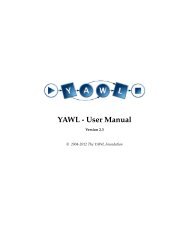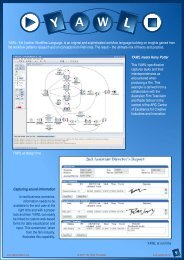Semantics, Verification, and Implementation of Workflows ... - YAWL
Semantics, Verification, and Implementation of Workflows ... - YAWL
Semantics, Verification, and Implementation of Workflows ... - YAWL
Create successful ePaper yourself
Turn your PDF publications into a flip-book with our unique Google optimized e-Paper software.
Chapter 2. Formal foundations<br />
c C,D<br />
Figure 2.8: An example E2WF-net for the net in Figure 2.7<br />
explicit EWF-net (E2WF-net) for the net in Figure 2.7. Note that a new condition<br />
c C,D has been introduced. We denote the set <strong>of</strong> conditions extended to include<br />
implicit conditions as C ext , <strong>and</strong> denote the extended flow relation as F ext . We<br />
now define an explicit extended workflow net (E2WF-net) using C ext <strong>and</strong> F ext as<br />
follows:<br />
Definition 2.27 (E2WF-net) Let N = (C, i, o, T, F, split, join, rem, n<strong>of</strong>i) be<br />
an EWF-net, the corresponding explicit EWF-net (E2WF-net) is defined as<br />
(C ext , i, o, T, F ext , split, join, rem, n<strong>of</strong>i) where<br />
C ext = C ∪ {c (t1 ,t 2 ) | (t 1 , t 2 ) ∈ F ∩ (T × T )} <strong>and</strong><br />
F ext =(F \ (T × T ))<br />
∪{(t 1 , c (t1 ,t 2 )) | (t 1 , t 2 ) ∈ F ∩ (T × T )}<br />
∪{(c (t1 ,t 2 ), t 2 ) | (t 1 , t 2 ) ∈ F ∩ (T × T )}.<br />
We assume that all EWF-nets considered are first transformed into E2WFnets.<br />
The notion <strong>of</strong> preset, postset, markings, <strong>and</strong> others defined for a reset net<br />
is also used for an E2WF-net. Similarly, the notion <strong>of</strong> initial <strong>and</strong> end markings<br />
defined for an RWF-net is also used for an E2WF-net where i, o are input <strong>and</strong><br />
output conditions. Since, an EWF-net is just a formal terminology for a <strong>YAWL</strong><br />
net, we propose to use the synonym “<strong>YAWL</strong> net” for an EWF-net. Similarly, we<br />
propose to use the term “e<strong>YAWL</strong>-net” (explicit <strong>YAWL</strong> net) for an E2WF-net.<br />
2.3.2 Structural properties<br />
Four structural properties <strong>of</strong> an e<strong>YAWL</strong>-net: soundness, weak soundness, irreducible<br />
cancellation regions, <strong>and</strong> immutable OR-joins are presented next.<br />
An e<strong>YAWL</strong>-net is sound if <strong>and</strong> only if it satisfies the following three criteria:<br />
option to complete, proper completion <strong>and</strong> no dead tasks. The soundness<br />
property <strong>of</strong> an e<strong>YAWL</strong>-net (Definition 2.28) is closely related to the soundness<br />
property <strong>of</strong> an RWF-net (Definition 2.22). The only difference is the type <strong>of</strong><br />
model being considered (RWF-net vs e<strong>YAWL</strong>-net).<br />
Definition 2.28 (Soundness) Let N be an e<strong>YAWL</strong>-net <strong>and</strong> M i , M o be the initial<br />
<strong>and</strong> end markings. N is sound iff:<br />
1. option to complete: for every marking M reachable from M i , there exists<br />
an occurrence sequence leading from M to M o , <strong>and</strong><br />
PhD Thesis – c○ 2006 M.T.K Wynn – Page 23





